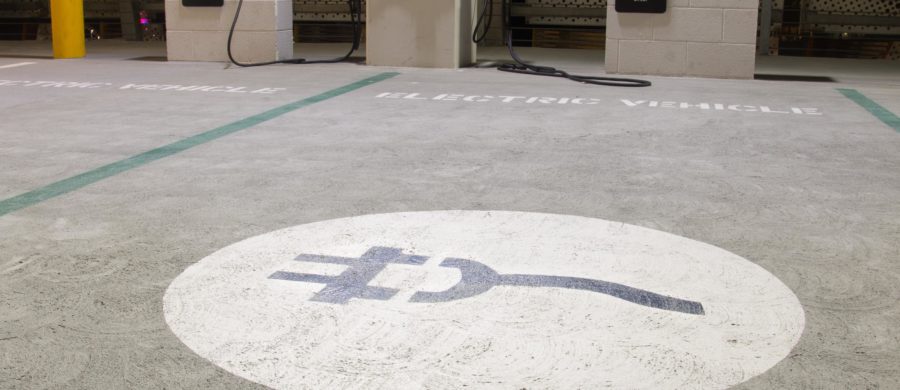
Batteries Not Included
Technology’s Stories vol. 5, no. 3 – doi: 10.15763/jou.ts.2017.08.27.01
PDF: Kapoor_Batteries Not Included
In 1881, Professor Silvanus Thompson, a physics lecturer at the University of Bristol applauded the development of accumulators (secondary batteries) and suggested that they offered a gateway to the future of railway transportation, demolition, telephony, wind/water power utilization, and lighting.[1] For Thompson, batteries were the obvious “next step,” or energy transition, in the expansion of electrical production and usage. His support for batteries drew on his (and others’) concerns over energy waste, the limited mobility imposed by electrical grids. More abstractly, he also critiqued engineers for failing to apply existing and promising scientific theory, a notion shared by several Victorian electrical specialists.[2]
More than a century later, in May 2015, Elon Musk used a similar argument while unveiling Tesla’s Powerwall©, a rechargeable battery his company designed to supply the average American home’s electric power consumption.[3] Consider the following video, in which Musk presents the “battery for the future” and critiques existing electric power production methods for their reliance on a wasteful (environmentally destructive), overly centralized, and outdated infrastructure:
Elon Musk Debuts The Tesla Powerwall-1 from Chris on Vimeo.
The parallels between Thompson’s and Musk’s enthusiasm for batteries is fascinating all by itself. What is perhaps more interesting, though, is the way that both of them challenge the routine dismissal of batteries as failed or inadequate technologies in the context of electric power production infrastructure.[4] When it comes to questions of success and failure, the history of the battery is tricky. This article examines this “history of failure” in order to show that failure, if it occurs at all, is not with battery but with the expectations of the battery in early and modern electric infrastructures.
Generally speaking, users consider technological failures are as definitive moments when one technology or system does not perform properly, or when it is replaced by something newer, and presumably, better.[5] It sounds easy. But historians of technology have shown that these so-called “failures” may not be quite as straightforward as popular commentators or innovators seem to think. Technologies may fail in one context and then succeed somewhere completely different. Components of a failed technology may reappear in completely new systems. Repeated failures may not discourage those deeply convinced of a technology’s value; continued development may make a technology finally work.[6] Despite the stigma surrounding failed technologies, moments when technologies don’t, or no longer work, attract a lot of scholarly and public interest, as people attempt to narrate a clean story of success and failure, endings and beginnings. Yet, excitement over new technologies, and fascination with relics tend to blind us to technologies which fail to meet expectations, yet persist in filling a meaningful role; technologies that, despite certain successes, remain secondary.
Batteries: Future or Failure?
The story of the battery, particularly the battery intended to store electric power, illustrates how a technology can be both a success and a failure. People have lost faith in batteries several times over the past century and a half, and yet batteries have not disappeared. On the contrary, batteries became and remain an essential auxiliary source of electric power in both large-and small-scale technologies. Batteries have never lived up to the potential that their makers envisioned, and yet inventors such as Musk continue to embrace the possibilities of greatly expanded dependence on batteries. A good question to ask then, is where exactly is the failure of the battery located? Is it just in the battery itself, its design, or the limits of the natural world? Or is it in the wider system in which batteries are incorporated? I argue that rather than thinking of the batteries individually, we need to think about them in the context of larger systems.
The utility of batteries for the storage of electric power has occupied the minds of electrical philosophers, tinkerers, and scientists for nearly two centuries. In 1799, Alessandro Volta (1745-1827) built the first electrochemical battery, or pile. Famously, in 1831 Michael Faraday (1791-1867) developed the first electrochemical battery in an experiment to demonstrate electromagnetism. By the 1860s, batteries, or accumulators, had garnered increasing attention, especially among electrical specialists (scientists and engineers) in Great Britain and France. John Frederic Daniell (1790-1845), Gaston Plante (1834-1899), and Camille Alphonse Faure (1840-1898) all developed ways to store more electric power for longer periods of time. In addition, battery technology became increasingly integrated into existing technological infrastructures, such as telegraph networks, where batteries helped sustain better telegraph signals. Still, the expense of batteries prohibited large scale production at that time, or at least deterred the will to try. Yet, that did not stop some scientists and engineers from hypothesizing, if not fantasizing, about the potential of batteries for expanding the use of electric power in society. Academic and popular journals rhapsodized over the wonders batteries might hold.[7] (See figures 1 and 2).
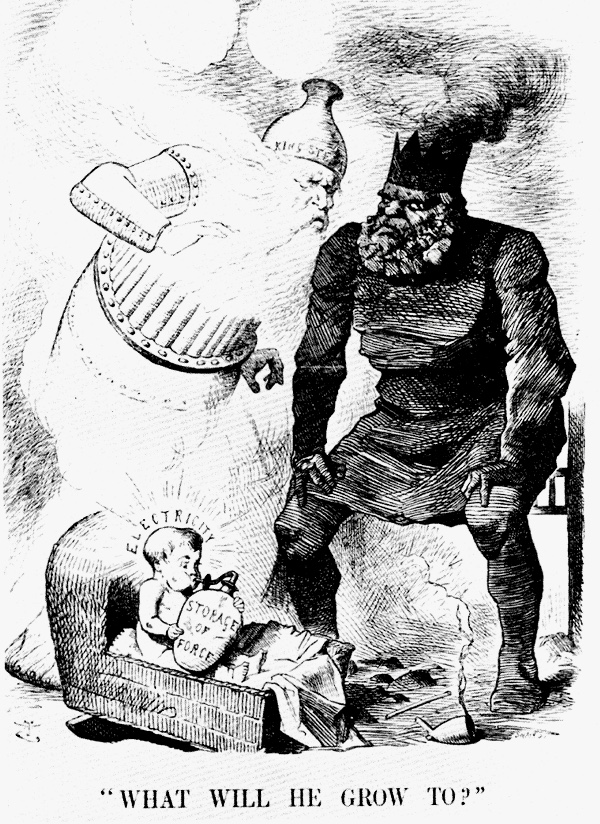
This well-known engraving captures the combination of wonder, curiosity, and anxiety people felt about electricity in late-nineteenth century Britain as a potential replacement of existing prime movers, like steam and coal. “What will he grow to?” Punch 1881, June 25, 295.
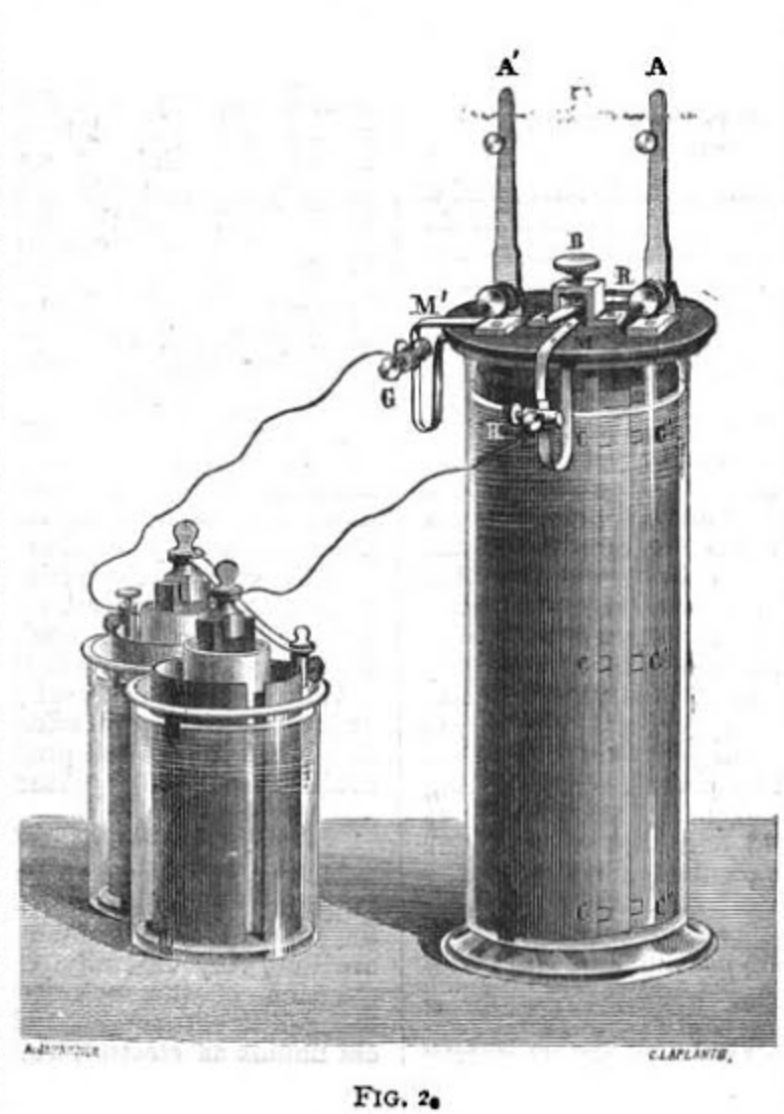
Thompson’s configuration of a Plante cell. In this diagram, he demonstrated how to recharge the larger, main cell. Silvanus Thompson, “The Storage of Electricity,” Journal of the Society of Arts, November 25, 1881, 38.
For example, Silvanus Thompson, published frequently on batteries in the Telegraphic Journal and Electrical Review and in publications of the British Association for the Advancement of Science. Thompson offered some of his liveliest praise of the battery in a paper published in the wake of the 1881 Paris Exhibition of Electricity—an event in which electrical scientists and engineers demonstrated numerous technologies, such as lighthouses, street light systems, communication technologies.
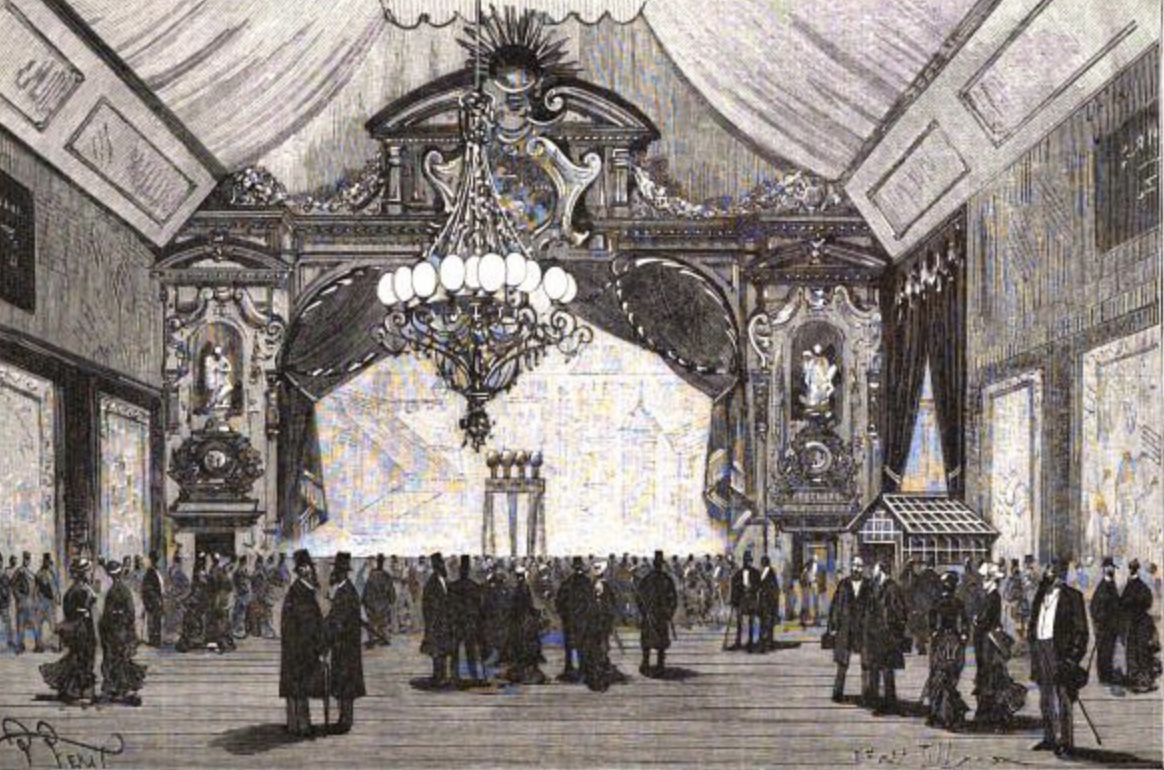
An electric lighting demonstration at the exhibition. “The Exhibition in Paris,” The Electrician, December 3, 1881, 42
Thompson expressed great interest in accumulators like the Faure and Plante Cells, which he considered as representative of the power production of the future. He was particularly enamored of the “Eclipse” Battery, invented by Henry I. Harris.[8] To him these technologies represented the power production of the future. Thompson extolled the Eclipse’s 13-hour charge, which he projected would be useful for electric lighting and possibly even the powering of street cars. He also believed that that secondary batteries could be used to provide lighting in trains, and that those batteries could be recharged continuously by the action of a dynamo applied to the turning motion of the train’s wheels. He even suggested that batteries could be used in military applications like torpedoes, as the decrease in battery sizes could make room for more explosives.
One of his most powerful examples however, emphasized the use of secondary batteries in connection with wind and water power installations, promising, in his view, an “endless supply” of electrical energy. In a discussion on tidal power he said, “Accumulators are a necessary feature in any scheme to utilize the intermittent force of the tides. Whether the present form will prove adequate for the purpose the future must decide.”[9] He was not the only one who dreamed about continuous electricity production using a combination of wind or water and batteries. For example, James Blyth (1839-1906), an engineer and inventor developed wind turbines that used secondary batteries to store electric power.
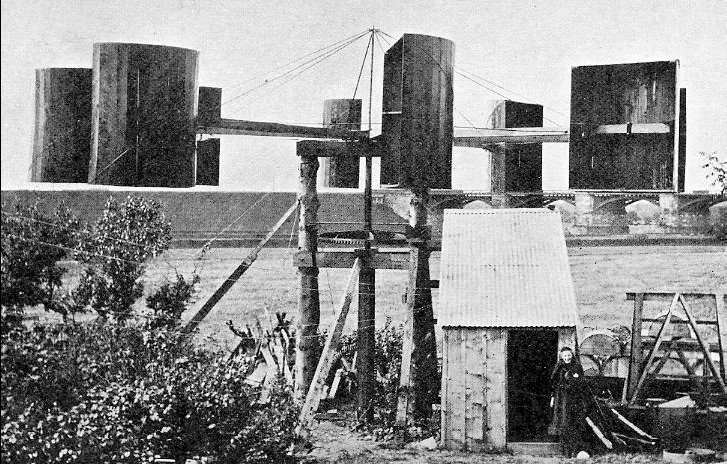
James Blyth’s “battery-charging” turbine, which was built at his holiday estate in Marykirk c. 1891.
It is easy to dismiss Thompson’s lecture as fanciful thinking and categorize the inventions he lists as no more than clever ideas. After all, few of them were ultimately integrated into the developing electrical infrastructure. What is worth noticing however, is not just Thompson’s dreams for batteries, but his wider vision of the systems of electricity production in which batteries were just one part a vision shared with other electrical experts of the time.[10] He was also a noted critic of the monopolization of electric power supply companies.[11] Thompson proposed an electrical infrastructure that depended on much less on centralized power stations than those that ultimately triumphed. Thompson’s idealized electric streetcars would be able to go places far from the urban centers of power production, and showed Thompsons’ priority of both mobility, and decentralized living. Likewise both he and Blyth advocated developing wind and water power in ways that would not require centralized power grids. The batteries imagined by advocates did not have to produce megawatts of electricity to be meaningful.[12]
As hydro-power and fossil fuel systems developed, even many of the early-battery proponents came to see batteries as too expensive. Silvanus Thompson’s positive opinions about batteries received a fair amount of attention in other journals of the day; those critical of the battery’s practicality targeted him particularly.[13] For instance, one author deriding the expenses of batteries argued:
Professor Silvanus[sic] Thompson says “there is money in it,” but even he would not like to pay such a price for a primary battery, and take the risk of recouping himself by the ordinary course of commercial operations.[14]
In subsequent reviews, electrical specialists derided Thompson’s speculations about the battery as “such balderdash.”[15] One reviewer, under the nom de plume, “In Darkness” argued that Thompson ignored the realities of existing battery technologies. Even if they were useful for small lighting set ups, to think they might one day power cable cars was utter nonsense. Whereas others who supported the implementation worried about how much power was wasted in battery storage. This was a major critique offered by William Thomson (after 1892 Lord Kelvin), who was initially supportive of applying battery technologies more widely. By the late 1890s, even he dismissed batteries as ineffectual for the developing grid because of their great expense. [16] Turbines like the Parson’s steam turbine, had proven extremely effective in generating electricity and, for many, showed far more promise.[17]
It was not simply that batteries cost too much to make. The hesitation also came from the cost and risk associated with either reconfiguring systems to include batteries or completely replacing existing structures.[18] Cities had already adopted the model of centralized systems, which worked well both technologically and for business interests, and the introduction of electricity made it easier to adapt electrical systems to existing utilities than to reimagine them altogether.[19] For instance, electricity could be used in water distribution facilities, or power line construction could follow gas lines. Following established utilities, rather than starting from scratch was particularly valuable for those hoping to adapt electricity to manufacturing.[20] Thus, implementing batteries demanded more than just working batteries. It also required people to rethink how they might organize the provision of utilities – a much bigger problem.
Despite such dismissals of the battery’s potential, research and speculation on the battery did not come to a halt. In fact, numerous electric power projects centered on battery technology, such as the rapid development of the electric car.[21] Still, batteries continued to be surrounded by an aura of failure and to be associated with a rhetoric of expense and impracticality. Battery development continued, but not in the general production of electricity. Instead they thrived when multi-purpose functions for controlling electric currents, or portable electric supplies were needed.[22]
Batteries came to be associated simultaneously with failure, and immense promise. Even though there was continued discussion of battery’s failures, others consistently added the “future battery” to their speculative sociotechnical visions of times to come. They were often centerpieces in the futures of William Morris and H. G. Wells, and they feature just as prominently in the marketing hyperbole of the modern green energy industry.[23] Thus, as we look at contemporary aspirations for the battery, we need to be aware of the ways our expectations are predicated on one particular model of electric power supply, that of centralized power stations.
“Back to the Future”
Looking through recent technology talks, expos, and magazines which explore energy, climate change, poverty, and global development, one would be hard pressed to find the presence of something about the potential of batteries to “solve our problems” unless it fits into the model of a centralized grid. In the past few decades, particularly since the fuel shortage in the 1970s, the storage of electrochemical power has been a bottleneck in the automotive and personal computing industries. Those industries have responded with a slew of developments and products such as fuel cells, zero-emission vehicles, and increased battery life on mobile devices. Still, there is a sense that these systems are wanting, and that they are often too expensive or impractical to implement on a large-scale.
To solve our problems of energy supply and sustainability, we have to start thinking not just of weakness of batteries as components in existing systems, but of ways we might want to reconfigure the systems themselves. To portray the battery as the “missing piece” is to misunderstand the nature of the problem. Branding the battery this way creates impossible expectations that perpetuate both the burdens of continued failure and the deferral of hope to an unspecified time in the future. We have clear ideas about where batteries are essential, such as in hand held devices or spaces where we are forced to be “disconnected.” But we also have ideas about where batteries are not suitable, such as factories or city power stations. The advent of larger batteries has not been enough to challenge this division of labor, as the constant increase in electric power consumption makes relying on existing infrastructures the quickest solution.[24]
It is easy to dismiss batteries as a failure, as many of Thompson’s peers did, and Musk’s still do. Today, just as then, this is an error. The failure is not “in” the battery. Instead, it is in its incompatibility with a system of centralized electric power production. But could reconfiguring our own ideas about how best to create and distribute electricity provide us with a different answer? What aspects of energy production and consumption practices ought we be thinking about changing? With these questions, we can begin both to appreciate how closely our energy infrastructures are tied to our cultural, economic, and political habits, and to consider how to tackle the difficult task of energy transition.
Nathan Kapoor is a PhD candidate at the University of Oklahoma. His dissertation investigates the relationship between empire and electrification in New Zealand during the late nineteenth and early twentieth centuries.
Suggested Readings
Eisler, Matthew. Overpotential: Fuel Cells, Futurism, and the Making of a Power Panacea. New Brunswick, New Jersey: Rutgers University Press, 2012.
Salkind, Alvin J., ed. Proceedings of the Symposium on History of Battery Technology. Pennington, NJ: Electrochemical Society, 1987.
Bibliography
“Electro-motive Power.” The Edinburgh Review, January 1882: 58.
“Electric Light and Force.” The Eclectic Magazine, 34 (882): 315.
“Examination Papers.” The Telegraphic Journal and Electrical Review, 21:504 (July 22, 1887): 73-74.
“The Eclipse Battery.” Telegraphic Journal and Electrical Review, August 5, 1887: 146.
“The Johnson Storage Battery.” The Telegraphic Journal and Electrical Review, October 17, 1890: 446.
“Electricity and Manufacture.” Electricity and Power 5:55 (1893), 132.
“Proceedings of the Northern Society for Electrical Engineers.” Telegraphic Journal and Electrical Review, 37:943 (December 20, 1895): 811.
“Trend over 1990-2017.” Global Energy Statistical Yearbook, Accessed July 17, 2017, https://yearbook.enerdata.net/electricity/electricity-domestic-consumption-data.html
Ball, Robert S. Natural Sources of Power. New York: D. Van Nostrand and Company, 1908.
Blyth, James. “On the Application of Wind Power to the Production of Electric Currents.” Proceedings of the Royal Scottish Society of Arts, January 25, 1892: 173-181.
Curry, Helen. “Industrial Evolution: Mechanical and Biological Innovation at the General Electric Research Laboratory.” Technology and Culture 54:4 (2013): 746-781.
Davies, Alex. “Elon Musk’s Grand Plan to Power the World with Batteries.” Wired, May 1, 2015. Accessed June 16, 2017. https://www.wired.com/2015/05/tesla-batteries/
Eisler, Matthew. Overpotential: Fuel Cells, Futurism, and the Making of a Power Panacea. New Brunswick, New Jersey: Rutgers University Press, 2012.
Epstein, L. “Twenty-Five Years Progress in Secondary Batteries.” Telegraphic Journal and Electrical Review, November 12, 1897: 632.
Ewing, J. A. “Abstract Report on Trials of Parson’s Condensing Steam Turbine.” The Electrical Engineer, November 11, 1892: 482-483.
Gold, Barri J. Thermopoetics: Energy in Victorian Literature and Science. Cambridge, Massachusetts: The MIT Press, 2010.
Gooday, Graeme. “Rewriting the ‘Book of Blots’: Critical Reflections on Histories of Technological ‘Failure.’” History and Technology 14:2 (1998): 265-291.
Greer, Henry Recent Wonders in Electricity, Electric Lighting, Magnetism, Telegraphy, and Telephony. New York: N.Y. Agent College of Engineering, 1883.
Hillyard, W. K. and Newnes, G. “Great Britain Patent: 7500-Apparatus for utilising wind pressure to induce electricity, and for other purposes”, May 9, 1885. Telegraphic Journal and Electrical Review 16, (1885): 477.
Hintz, Eric S. “Portable Power: Inventor Samuel Ruben and the Birth of Duracell.” Technology and Culture 50: (2009), 24-57.
Jones, Christopher. Routes of Power: Energy in Modern America. Cambridge, MA: Harvard University Press, 2014.
Kirsch, David A. The Electric Vehicle and the Burden of History. New Brunswick, New Jersey: Rutgers University Press, 2000.
Lipartito, Kenneth. “Picturephone and the Information Age: The Social Meaning of Failure.” Technology and Culture 44:1 (2003): 50-81.
Malm, Andreas, “Fleeing the Flowing Commons: Robert Thom, Water Reservoir Schemes, and the Shift to Steam Power in Early Nineteenth-Century Britain.” Environmental History 19:1 (2014): 55-77.
Marsden, Ben. “Blowing Hot and Cold: Reports and Retorts on the Status of the Air-Engine as Success or Failure.” History of Science 36:4 (1998): 373–420.
Martin, Richard. “Tesla-SolarCity Success Depends on Battery Technology That Doesn’t Yet Exist.” The MIT Technology Review, June 26, 2016. Accessed June 16, 2017. https://www.technologyreview.com/s/601757/tesla-solarcity-success-depends-on-battery-technology-that-doesnt-yet-exist/
McCray, Patrick. “What Makes a Failure? Designing a New National Telescope, 1975-1984.” Technology and Culture 42:2 (2001): 265-291.
Robinson, Henry and Nursey, Perry F. “Primary Batteries for Illuminating Purposes.” Journal for the Society of Engineers, November 7, 1887: 203.
Salkind, Alvin J., ed. Proceedings of the Symposium on History of Battery Technology. Pennington, NJ: Electrochemical Society, 1987.
Sheible, Albert. “The Problem of Heat Cells,” The Electrical Engineer, June 27, 1890: 505.
Siemens, C. W., “Presidential Address.” Telegraphic Journal and Electrical Review 11 (1882): 146.
Snell, C. Scott. “The Sea–A Source of Power,” Telegraphic Journal and Electrical Review 11 (1882): 454-455.
Thompson, Silvanus P. “Storage of Electricity.” The Electrician 8:2 (1881): 22-55
Thomson, Sir William, “Address to the Mathematical and Physical Science Section of the British Association.” The Chemical New and Physical Sciences Journal 44, no. 138 (1881), 135-137.
Tomory, Leslie. “London’s Water Supply before 1800 and the Roots of the Networked City.” Technology and Culture 56:3 (2015): 704-37.
Wolff, Alfred R. The Windmill: As a Prime Mover. New York: John Wiley and Sons, 1894.
[1] Silvanus is also spelled Sylvanus in some primary and secondary sources. I have opted to use the spelling “Silvanus” on the recommendation of Graeme Gooday. Thompson, “Storage of Electricity,” 22-55.
[2] Blyth, “On the Application of Wind Power to the Production of Electric Currents,” 173-181; Thomson, “Address to the Mathematical and Physical Science Section of the British Association for the Advancement of Science,” 135-137; Snell. “The Sea–A Source of Power,” 454-455.
[3] Davies, “Elon Musk’s Grand Plan to Power the World with Batteries.”
[4] Martin, “Tesla-SolarCity Success Depends on Battery Technology That Doesn’t Yet Exist.”
[5] McCray, “What Makes a Failure?”, 266.
[6] For more on “failed” technology literature see: Lipartito, “Picturephone and the Information Age.” Other works include Marsden, “Blowing Hot and Cold;” Gooday, “Rewriting the ‘Book of;” Mara Fjaestad, “Fast Breeder Reactors in Sweden;” Curry, “Industrial Evolution.”.
[7] Schiffer, Power Struggles.
[8] We only know this figure, Henry I. Harris, from a patent and citation. Other biographical information appears not to be available. Robinson and Nursey, “Primary Batteries for Illuminating Purposes,” 203.
[9] “Electro-motive Power,” 58.
[10] For many improved batteries opened the potential for different ways to generate electric power: Wolff, The Windmill; Siemens, C. W., “Presidential Address,” 146; Hillyard, W. K. and Newnes, G. “Great Britain Patent,” 477; Ball, Natural Sources of Power.
[11] “Proceedings of the Northern Society for Electrical Engineers,” 811.
[12] Greer, Recent Wonders, 17-18.
[13] The following periodical references contain discussion of Thompson’s work with batteries: “Electric Light and Force,” 315; “The Johnson Storage Battery,” 446.
[14] “Examination Papers,” 73-74.
[15] “The Eclipse Battery,” 146.
[16] Epstein, “Twenty-Five Years Progress in Secondary Batteries,” 632.
[17] Ewing, “Abstract Report on Trials of Parson’s Condensing Steam Turbine,” 482-483.
[18] Albert Scheible. “The Problem of Heat Cells,” 505. For other works covering the difficulties in other energy system changes, see Andreas Malm “Fleeing the Flowing Commons”; Christopher Jones, Routes of Power.
[19] Tomory, “London’s Water Supply before 1800 and the Roots of the Networked City,” 704-707.
[20] “Electricity and Manufacture,” Electricity and Power, 132.
[21] Kirsch, The Electric Vehicle, 4-5.
[22] Eric Hintz, “Portable Power,” 26-27; Eisler, Overpotential, 20-21
[23] Gold, Thermopoetics, 13-14; Salkind, ed. Proceedings of the Symposium on History of Battery Technology; Hintz, “Portable Power.”.”
[24] “Trend over 1990-2017.”
